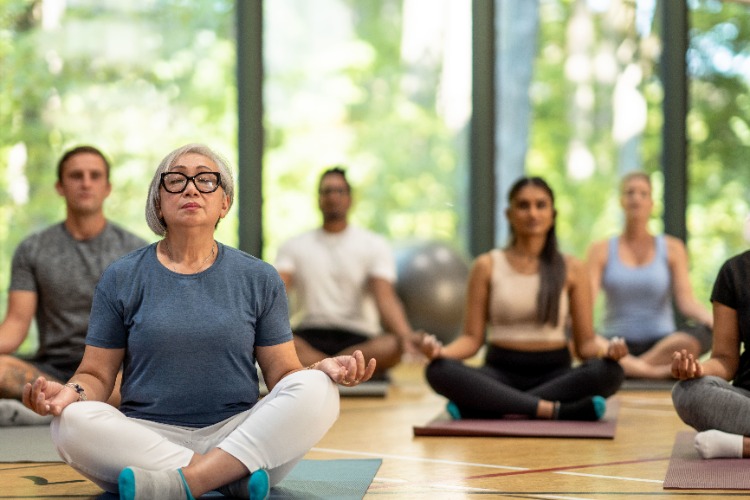Building a thriving community of health and wellness
Published by HealthFitness on December 12th, 2025
In today’s evolving workplace, fostering a community of health and wellness is more than a perk — it’s a necessity. With employees spanning multiple generations and working in diverse settings—from corporate offices to remote job sites—it’s critical to create inclusive wellness programs that connect and support everyone.

Tiffany Jones, Contract Manager at HealthFitness, shared insights into how her team is successfully cultivating a strong sense of community in the wellness programs they oversee. Through a blend of engagement strategies, collaborative partnerships, and personalized approaches, they’re making wellness a unifying force in their client’s organization.
Why Community Matters in Workplace Wellness
Community is the glue that keeps employees engaged in their health journey. It fosters accountability, motivation, and connection—key factors in driving sustained participation in wellness programs. Tiffany emphasizes that while the benefits of health and wellness programs are well known, the challenge is getting employees to actively engage. That’s where a sense of community makes all the difference.
For example, at their energy sector client, where employees range from field technicians and linemen to corporate professionals, the team has implemented creative ways to bring people together, ensuring no one feels isolated in their wellness journey.
Simple, Effective Ways to Build Community in Workplace Wellness Programs
1. Shared Interests Create Natural Connections
One successful initiative was a Collegiate Check-In Challenge, where employees checked in based on their alma mater. This fun and simple contest led to surprising connections—employees discovering shared backgrounds and strengthening their sense of belonging.
2. Healthy Competition Inspires Participation
Step challenges are a staple in workplace wellness, and Tiffany’s team takes them to the next level. Employees form teams, sync their wearables, and find creative ways to increase their step count. From taking breaks together to choosing the farthest parking spots, these challenges foster teamwork and make movement fun.
3. Collaborating Across Vendors for a Holistic Approach
Recognizing that health goes beyond physical fitness, the team collaborates with Employee Assistance Programs and clinical providers to address behavioral and dietary health. By integrating expertise across these areas, they create comprehensive wellness programs that tackle common struggles employees face, ensuring a well-rounded support system.
Bridging Generational and Geographic Gaps in Workplace Wellness
With a workforce spanning multiple generations, one size does not fit all. Tiffany’s team recognizes that different age groups engage with wellness differently. Traditional Lunch & Learns work well for some, while younger employees prefer on-demand podcasts they can listen to while working.
Even in their step challenges, they accommodate varying preferences—some employees track their steps through apps, while others stick to old-school pedometers and handwritten logs. By offering flexible engagement options, they ensure participation across all demographics.
Learn how to bridge the generational gaps in workplace wellness.
The Role of Wellness Ambassadors in Scaling Impact
With just 15 wellness professionals supporting 20,000 employees, the team relies on Wellness Ambassadors—passionate employees who volunteer to champion wellness initiatives in their locations. These ambassadors provide crucial feedback, extend the program’s reach, and create local wellness communities where employees feel heard and supported.
Balancing Technology with Human Connection
Technology is an excellent supplement to wellness programs, but it’s not a replacement for human interaction. When their client introduced a wellness technology platform, Tiffany’s team ensured that it complemented — not replaced — their human-centered engagement. The result? A seamless integration that leverages digital tools while preserving the personal connections that drive real behavior change.
Key Takeaways for HR and Benefits Leaders
- Community drives engagement: Employees are more likely to participate when wellness feels social and inclusive.
- Flexibility is essential: Offer multiple ways to engage across generations and locations.
- Leverage employee ambassadors: Peer champions extend reach and strengthen trust.
- Integrate, don’t isolate: Align wellness, mental health, and clinical resources for holistic support.
- Balance tech with human touch: Digital tools should enhance—not replace—personal connection.
A thriving wellness program is more than a collection of benefits—it’s a wellness community. When that community flourishes, so does employee health, engagement, and organizational performance.
Frequently Asked Questions (FAQs)
What is a community-based workplace wellness program?
A community-based workplace wellness program focuses on shared experiences, peer engagement, and social connection to improve participation and health outcomes.
Why do employees disengage from wellness programs?
Common reasons include lack of relevance, limited flexibility, and feeling isolated. Community-driven design helps overcome these barriers.
How can wellness programs engage remote and field employees?
By offering digital resources, flexible participation options, and local wellness ambassadors, organizations can engage employees regardless of location.
Do wellness ambassadors really work?
Yes. Peer-led initiatives increase trust, participation, and program visibility—especially in large or dispersed organizations.
How should technology be used in workplace wellness?
Technology should support data tracking, communication, and personalization while maintaining human-centered engagement strategies.
Bottom line: Employees don’t just need access to wellness resources—they need connection. Build community first, and engagement will follow.
Interested in learning more? Check out The HealthFitness Podcast and learn how to create a community of health and wellness.